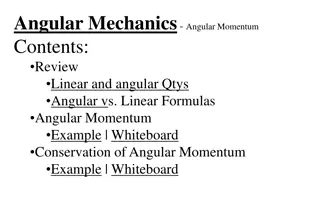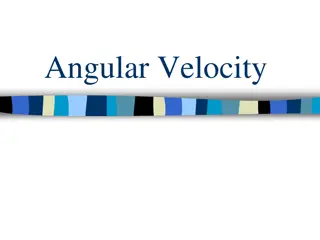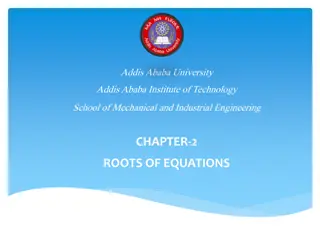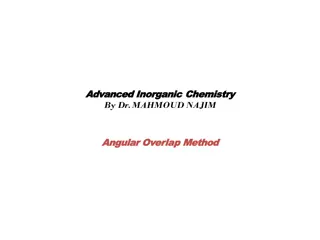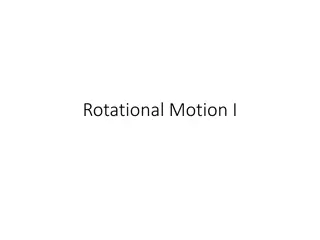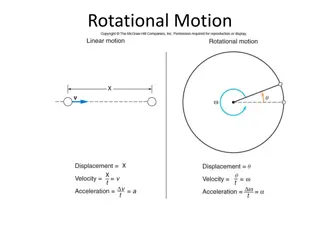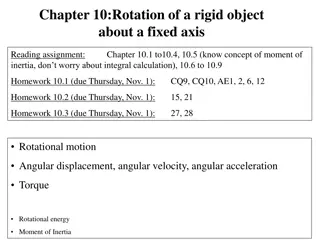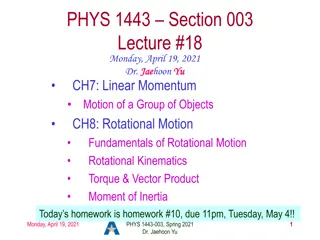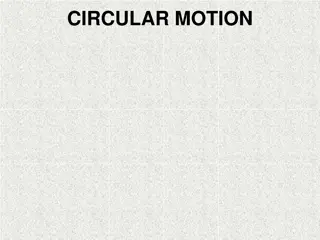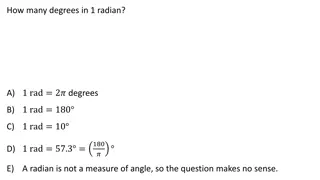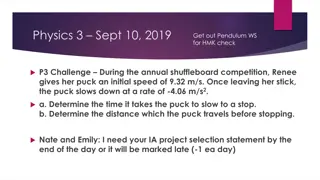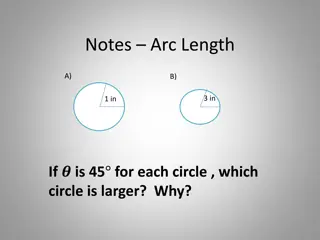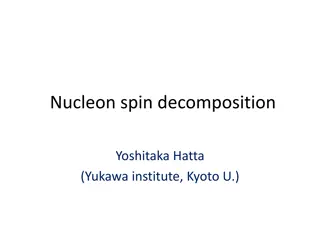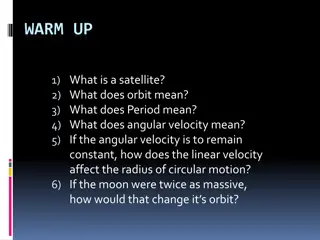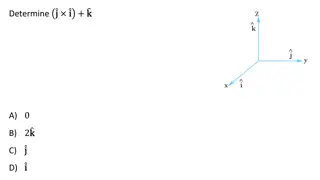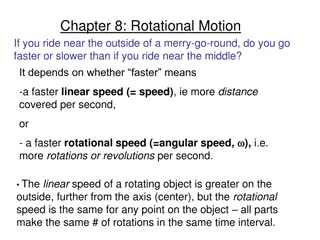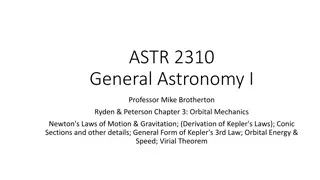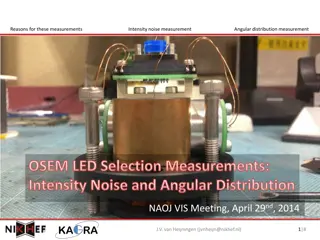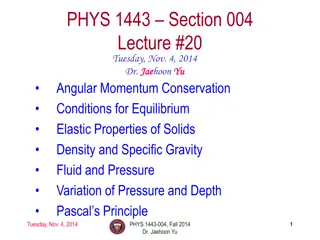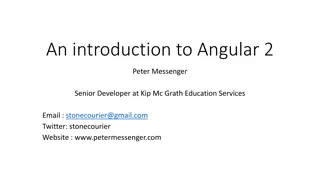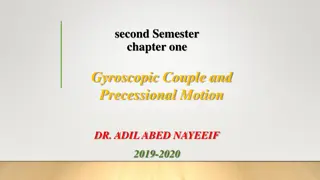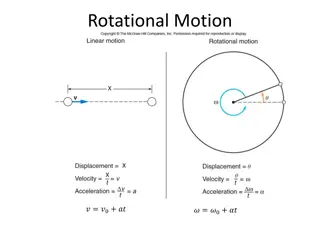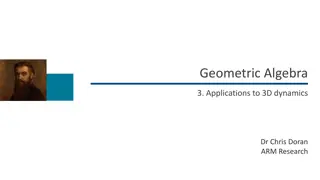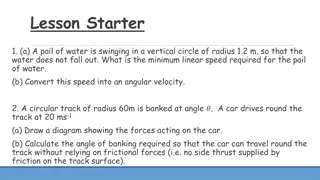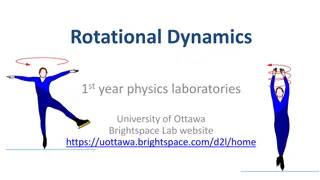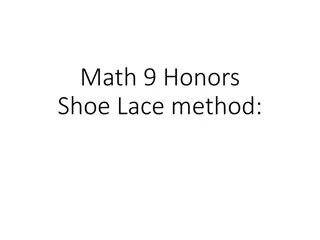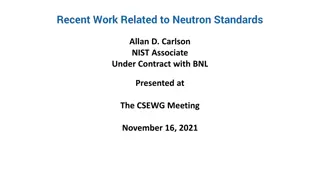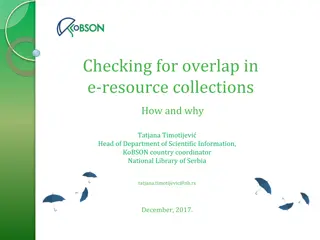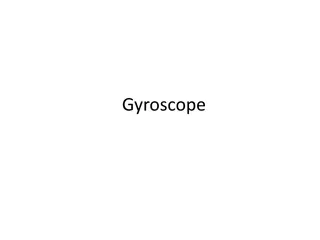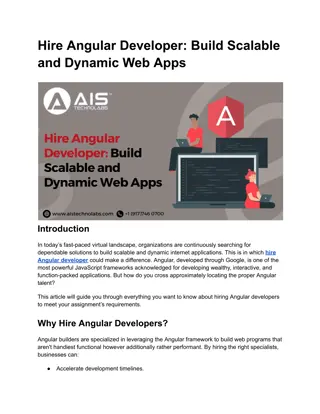Angular Momentum in Mechanics
Explore the key concepts of angular momentum in mechanics, including the difference between linear and angular quantities, angular momentum calculations, conservation principles, and practical examples illustrated on whiteboards. Delve into formulas, equations, and scenarios to grasp the fundamental
5 views • 27 slides
Angular Mechanics - Angular Momentum Concepts and Examples
Understanding angular momentum in mechanics involves reviewing linear and angular quantities, comparing angular to linear formulas, and exploring examples of angular momentum and conservation principles. The content covers key factors like angular quantities, torque, and moment of inertia, along wit
3 views • 23 slides
Rotational Motion: Angular Velocity and Acceleration
Explore the concepts of angular velocity, radians, and rotational motion in this educational content. Learn about the relationship between angular and linear velocity, angular acceleration, tangential acceleration, and centripetal acceleration through practical examples. Enhance your understanding o
4 views • 17 slides
Angular Momentum in Quantum Mechanics
Exploring the concept of total angular momentum in quantum mechanics, which involves the quantization of orbital and spin angular momenta. The coupling of these vectors leads to the formation of total angular momentum, with implications for the behavior of single-electron systems like the hydrogen a
0 views • 16 slides
Roots of Equations in Engineering: Methods and Techniques
Roots of equations are values of x where f(x) = 0. This chapter explores various techniques to find roots, such as graphical methods, bisection method, false position method, fixed-point iteration, Newton-Raphson method, and secant method. Graphical techniques provide rough estimates, while numerica
0 views • 13 slides
Angular Overlap Method in Advanced Inorganic Chemistry
Exploring the Angular Overlap Method (AOM) in advanced inorganic chemistry provides a qualitative discussion on the physical rationale behind the theory of complexes. By considering the interaction of atomic orbitals and the degree of overlap, AOM offers insights into energy quantification in coordi
0 views • 15 slides
Rotational Motion and the Radian
Rotational motion involves rotation around a fixed axis, while the radian measures angular displacement. The relationship between translational and rotational motion is explored, defining angular velocity and differentiating between clockwise and counterclockwise rotations. Examples illustrate the c
0 views • 23 slides
Rotational Motion in Physics
Exploring rotational motion in physics involves understanding angular velocity, torque, moment of inertia, and rotational kinetic energy. This comprehensive guide covers concepts such as the conversion between degrees and radians, angular variables, Newton's second law for rotating bodies, and momen
0 views • 18 slides
Rotational Motion in Chapter 10
Exploring the concepts of rotational motion in a rigid object, focusing on angular displacement, velocity, acceleration, torque, and moment of inertia. Key topics include angular quantities, relationships between linear and angular motion, and applications in calculating rotational parameters. Pract
0 views • 29 slides
Linear and Rotational Motion in Physics
Explore the concepts of linear momentum, center of mass, rotational motion, and angular displacement in physics. Learn how to determine the center of mass of objects, analyze motion of particle groups, and understand the conservation of momentum in systems under external forces. Delve into the funda
0 views • 18 slides
Circular Motion in Physics
Circular motion involves objects moving in a circular path at a constant speed, experiencing acceleration and centripetal force. This motion is characterized by angular speed, centripetal acceleration, and the necessary centripetal force. The concept of uniform circular motion and angular displaceme
3 views • 38 slides
Physics Concepts: Angular Velocity, Radians, and Acceleration Explained
Understand essential physics concepts such as angular velocity in radians, comparison of angular velocities, tangential velocity, magnitudes of velocities, and angular acceleration as applied to various scenarios like rotating wheels, clock hands, and spinning objects. Dive into the relationships be
1 views • 31 slides
Physics Practice Problems: Wheels, Rotations, and Acceleration
Explore a series of physics practice problems related to wheels, rotations, angular velocity, tangential velocity, and acceleration. Dive into scenarios involving bicycles, skateboards, hard drives, and cars to test your understanding of these concepts. From calculating linear distances traveled to
0 views • 36 slides
Introduction to Rotational Motion in Physics
Explore the concepts of rotational motion in physics, including angular displacement, angular velocity, and angular acceleration. Understand how objects move in circular paths and learn about the relationships between linear and rotational variables. Dive into the study of extended bodies and the dy
0 views • 15 slides
Term Overlap Among Matportal Ontologies
The study focuses on term overlap among 5 Matportal ontologies, assessing interoperability and semantic ambiguity. Results show high rates of URI matches between specific ontologies, with discussions on the implications and potential solutions for enhancing interoperability.
0 views • 7 slides
Implementation of Angular Momentum Formalism in Low-Energy Fusion Reactions
This update focuses on integrating the angular momentum formalism into low-energy fusion reactions using the LISE++ platform. It explores fission barriers, potential energy pockets, compound formation, and de-excitation processes in fusion reactions. The documentation delves into fusion residue tran
0 views • 25 slides
Latitude and Angular Distance on Earth
This content explains the concepts of latitude, angular distance, and distances on Earth using images and descriptions. It covers topics such as North Pole latitude, parallels of latitude, angular distance calculations, nautical miles, and great circle distances. Explore how these concepts relate to
0 views • 12 slides
Arc Length and Angular Velocity in Circles
Explore the concept of arc length in circles and learn how to calculate it using the formula s = rθ. Discover the relationship between linear speed and angular velocity in circular motion and practice applying formulas to solve problems. Dive into converting revolutions to radians and mastering the
0 views • 19 slides
Nucleon Spin Decomposition and Proton Spin Problem
Explore the complex realm of nucleon spin decomposition and the enigmatic proton spin problem, delving into concepts like orbital angular momentum, quarks and gluons' helicity, and longitudinal double spin asymmetry in polarized deep inelastic scattering. Learn about the spin crisis, gluon polarizat
0 views • 26 slides
Satellite Orbits and Motion
Explore the concepts of satellites, orbits, period, and angular velocity in relation to circular motion. Learn how these factors affect the motion of objects in space and understand the relationship between linear and angular velocity. Discover the impact of mass on an object's orbit and how it infl
0 views • 7 slides
Angular Velocity, Torque, and Conservation of Angular Momentum in Physics
Earth's angular velocity, minute hand rotation, torque calculations, application of torque in balancing seesaws, motion equations, and car deceleration scenarios are explored. Concepts like rotational inertia, kinetic energy, and conservation of angular momentum are discussed, providing a comprehens
0 views • 6 slides
Angular Momentum and Rotational Dynamics in Physics
Explore concepts related to angular momentum, torque, and rotational dynamics in physics. Learn about the behavior of spinning objects, the effects of changing moments of inertia, and how angular momentum is conserved in different scenarios.
0 views • 35 slides
Rotational Motion: Linear vs. Angular Speed
Exploring the concept of rotational motion, this content delves into the comparison between linear speed (tangential speed) and rotational speed (angular speed). It discusses how the linear speed varies based on distance from the axis of rotation, while the rotational speed remains constant for all
0 views • 27 slides
Orbital Dynamics: From Newton's Laws to Kepler's Laws
Exploring the fascinating realm of orbital dynamics, this content delves into the application of Newton's laws to explain Kepler's laws and the intricacies of orbital mechanics. Deriving Kepler's laws from Newton's law of gravitation involves advanced mathematics, while also emphasizing the signific
0 views • 25 slides
Secure Your Angular App Using JWT and GraphQL
Ankit Sharma presents an insightful talk on securing Angular applications using JWT and GraphQL. He discusses the technology stack involving .NET, Angular, and GraphQL to create a secure API system with route guards. The talk explains the significance of JWT and when to use it, detailing its structu
0 views • 21 slides
Intensity Noise and Angular Distribution Measurements in LED Selection
The measurements focus on intensity noise and angular distribution to address variations in LED performance observed in LIGO papers. The study aims to investigate intensity noise dependence on LED current, differences between LED batches, and comparisons between them.
0 views • 8 slides
Angular Momentum Conservation in Physics: Understanding Principles and Applications
Explore the concept of angular momentum conservation in physics, covering conditions for equilibrium, elastic properties of solids, density, specific gravity, fluid dynamics, pressure variations, and Pascal's Principle. Delve into examples like neutron star rotation and planetary motion to understan
0 views • 15 slides
Angular 2 Overview and Benefits
Angular 2, developed by Google using TypeScript, is a popular JavaScript framework known for creating web and native applications. This post explores its features, benefits, development history, and the application being worked on by Peter Messenger. Learn about TypeScript advantages, components, an
0 views • 29 slides
Gyroscopic Couple and Precessional Motion in Second Semester Physics
Exploring the concepts of gyroscopic couple and precessional motion in the second semester of Physics, this content delves into the angular acceleration, vector diagrams, and components of angular acceleration. It also discusses the gyroscopic couple's impact on objects like a spinning disc and aero
0 views • 24 slides
Rotational Motion and Angular Variables in Physics
Exploring rotational motion in physics, including the definition of angles in radians, conversion between degrees and radians, angular variables, torque, Newton's second law for rotating bodies, moment of inertia, rotational kinetic energy, and angular momentum. Learn about key concepts and equation
0 views • 15 slides
Optimus Prime's Transformation Challenge: Angular Momentum and Moment of Inertia Exploration
Dr. Mark Huntress, a Chemistry and Physics professor, devises a transformative assignment on rotation. As Optimus Prime aims to rotate as fast as possible with minimal external forces, students explore whether he should transform into a disk, ring, or solid sphere. Through a four-part exploration in
0 views • 16 slides
Geometric Algebra Applications in 3D Dynamics with Dr. Chris Doran
Exploring the applications of geometric algebra in 3D dynamics, this content covers topics such as quaternions, inner products in rotations, angular momentum as a bivector, torque, conserving vectors in inverse-square force fields, rotating frames, and Lie group derivatives. The material delves into
0 views • 19 slides
Angular Momentum in Physics
Learn about the concept of angular momentum in physics through practical examples and explanations. Explore how angular momentum is conserved in rotating bodies and how it impacts various sports activities. Discover the relationships between moment of inertia, angular velocity, and conservation of a
0 views • 19 slides
Experimental Determination of Moment of Inertia in Rotational Dynamics Lab
In this university lab experiment, students apply known torques to various objects to measure angular accelerations and determine their moments of inertia. The setup involves rotating discs and rods with masses, using a rotational sensor for data collection. Important steps include measuring diamete
0 views • 12 slides
Shoe Lace Method for Finding Polygon Areas
The Shoe Lace Method is a mathematical process used to determine the area of any polygon by employing coordinate geometry. By following specific steps, including organizing coordinates, multiplying diagonally, and adding columns in a certain manner, the method allows for a straightforward calculatio
0 views • 8 slides
Recent Advancements in Neutron Standards Evaluation
Recent work by Allan D. Carlson, a NIST associate under contract with BNL, was presented at the CSEWG meeting discussing possible changes to neutron standards and showcasing important measurements, such as H(n,n)H angular distribution data by Jiang et al. and 6Li(n,t) reaction measurements by Bai et
0 views • 15 slides
Managing E-Resource Collections for Overlap Detection
Explore the process of checking for overlap in e-resource collections presented by Tatjana Timotijevic, Head of Department of Scientific Information at the National Library of Serbia. Discover how KoBSON's database facilitates the identification of content overlap in subscribed e-resources and learn
0 views • 21 slides
Gyroscopes and Angular Momentum
Explore the concept of gyroscopes, angular momentum, and gyroscopic effects in vehicles like ships and airplanes. Learn about mass moment of inertia, angular velocity, and the precession of gyroscopes in detail. Dive into the physics behind the change of angular momentum and solve a problem involvin
0 views • 12 slides
Hire PHP Developers_ Access the Top 1% for Outstanding Results
Looking to hire Angular developers? Build scalable & dynamic web apps. Hire AngularJS developers, programmers, or Angular developers in India. Contact AIS Technolabs.\n\nsource>>\/\/ \/hire-php-developers\n
1 views • 4 slides
Hire Angular Developer_ Build Scalable and Dynamic Web Apps
Looking to hire Angular developers? Build scalable & dynamic web apps. Hire AngularJS developers, programmers, or Angular developers in India. Contact AIS Technolabs.\n\nsource>>\/\/ \/hire-php-developers\n
0 views • 6 slides
